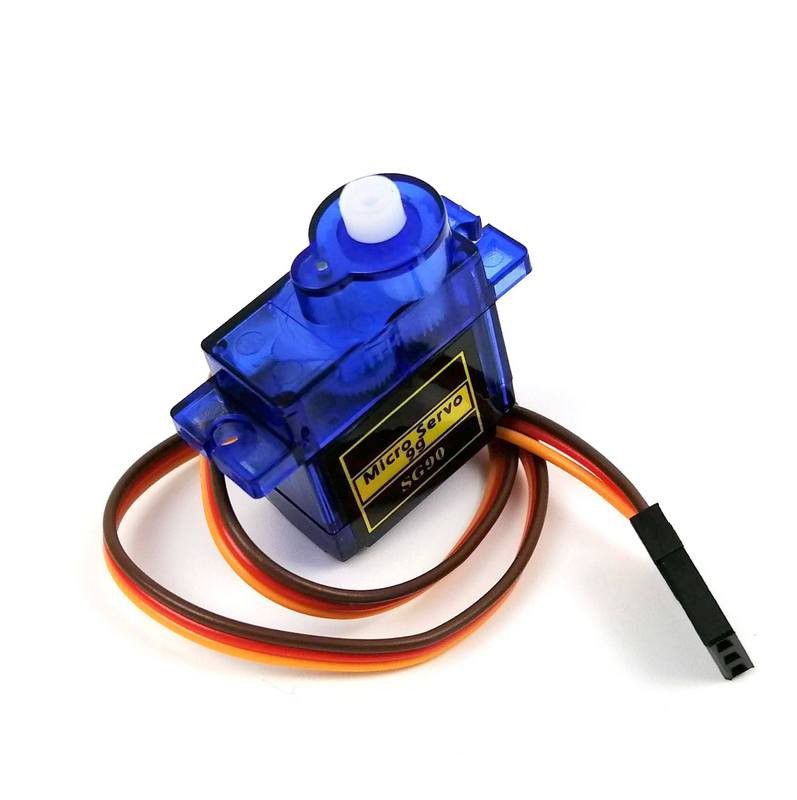
- #Sg90 servo motor arduino how to#
- #Sg90 servo motor arduino full#
- #Sg90 servo motor arduino code#
- #Sg90 servo motor arduino professional#
To change the position of the motor arm, you just need to provide a 50Hz PWM signal with a variable duty cycle. The SG90 servo motor we are using uses a closed-loop control system to control the shaft position of the motor. The job of a servo motor is to control the angle of rotation in a closed-loop control system and use the feedback to adjust the speed and angle of the motor to the active desired result.
#Sg90 servo motor arduino how to#
How to Control the Angle of the Servo Motor? You can check those out if you are interested. In one of our previous projects, we interfaced a Servo Motor Control with Arduino Due and we have also built Servo Position Control with Weight (Force Sensor) and many other Servo Motor based Projects.
#Sg90 servo motor arduino code#
In the end, we will be making a hardware circuit and write a bit of code to give you a better understanding of the servo motor and its working. So, in this article, we are going to interface a SG90 servo motor with ESP32 and in the process, we will let you know how a servo motor works with its internal circuitry. They are also used in aircraft to control surfaces such as elevators and ailerons.

Servo motors are used in a variety of applications where precise control of positioning is required, such as in robotics, CNC machines, and 3D printers. This feedback loop ensures that the motor shaft moves to its precise location specified by the control signal. The feedback mechanism is used to provide information about the position of the motor shaft to the control circuit, which then adjusts the power to the motor accordingly. It typically consists of a DC motor, a control circuit, and a feedback mechanism. Contact us today.A servo motor is a type of motor that is used to control the precise movement of a device.
#Sg90 servo motor arduino professional#
So, as you begin such projects, you must seek professional help in a community for developers. However, learning to use servo motors is one thing. Unlike DC motors, they have more pins, hence more functionality. The SG 90 servos, in particular, are lightweight and powerful simultaneously. In brief, servo motors are an important part of robotic applications. Due to its lightweight nature, it is useful in multi-DOF humanoid robots.Robots requiring position control without feedback use this motor.Also, it is a common part of RC toys’ steering mechanism.Servo motors function as robot actuators in hexapods, biped robots, and robotic arms.In this case, you need an external power supply. Note: If you are using multiple servos, Arduino does not meet the high current demands of the motors to power them. Next, you have to write the Arduino code for the application.This connection lets you send servo directions like PWM pulses to the motor. Firstly, connect the servo signal pin to the Arduino digital pin 8.(A servo motor connection to Arduino) Operational steps To use SG90 servos on Arduino, you need the following components: How to use sg 90 servos on Arduino? The required components This motor, for instance, can pull weights up to 2.5kg from 1cm away.

The most common torque rating among servo motors is the 2.5kg/cm in the Towerpro SG90 Motor. Metal gears are a good alternative if your application is long-running and needs a stronger engine. So, if your project demands more than a half-circle, it is best to go for a 360-degree rotation motor.
#Sg90 servo motor arduino full#
When the project demands full circle turnsĪlso, most hobby servo motors only rotate as much as 180 degrees.A higher voltage, in this case, produces higher torque. Temperatures between 0℃ and 55℃ are optimal for operation.įirst, hobby servo motors operate within a 4.8V to 6.5V range.As well, the operating speed is 0.1s/60 degrees.Also, it has an operating voltage rated 4.8V.The dimensions of the device are 31 x 11.8 x 22.2 mm.The average weight of the SG90 is 9 grams.(Servo Motor showing all three wires) SG-90 Features This orange wire carries the PWM signal to drive the micro servo. The +5V here is the power pin that supplies the motor. This brown wire connects the micro servo to the ground. Servo Motor Wire Configuration Wire Number Also, the output power is high and works like standard servos, although smaller. SG 90 servos are lightweight motors that rotate 90 degrees in every direction.

As we advance, you learn about SG90 servo and how to put it to use. Often, you need a microcontroller such as an Arduino, Raspberry Pi, etc.

However, these hardware devices don’t work independently. However, only a few devices can control objects with such high precision as the SG 90 Servos. What you may not know is that a major component is a micro servo. This is because of how easy it is to change the gear, velocity, and acceleration. We are all fascinated with the mechanics behind RC vehicles.


 0 kommentar(er)
0 kommentar(er)
